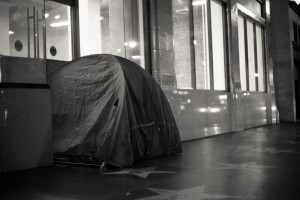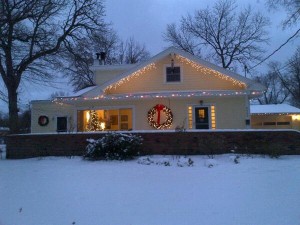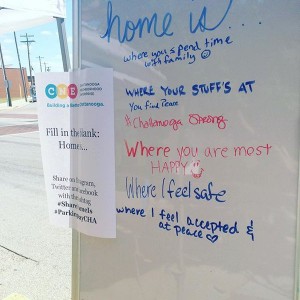Home is…where your mom is. #sharehomeis homemattersamerica.com/home-full-grid/
Monthly Archives: November 2015
Tweet: Home is a roaring fireplace in the winter #ShareHo…
Status
Tweet: Share what you are thankful for this Thanksgiving…
Status
Share what you are thankful for this Thanksgiving with the hashtag #ShareHomeIs https://t.co/dIyaOCyVos

Tweet: Share what you are thankful for this Thanksgiving…
Status
Share what you are thankful for this Thanksgiving with the hashtag #ShareHomeIs ow.ly/i/e1mGt
Tweet: Share what you are thankful for this Thanksgiving…
Status
Share what you are thankful for this Thanksgiving with the hashtag #ShareHomeIs https://t.co/ybryRJQRug
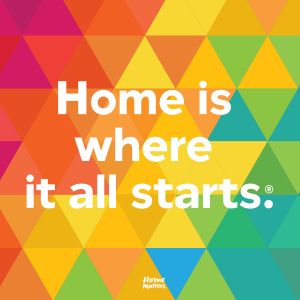
Tweet: Share what you are thankful for this Thanksgiving…
Status
Share what you are thankful for this Thanksgiving with the hashtag #ShareHomeIs
Tweet: Share what you are thankful for this Thanksgiving…
Status
Share what you are thankful for this Thanksgiving with the hashtag #ShareHomeIs ow.ly/i/dZbD3
Tweet: Share what you are thankful for this Thanksgiving…
Status
Share what you are thankful for this Thanksgiving with the hashtag #ShareHomeIs https://t.co/NjQFJxXtDK
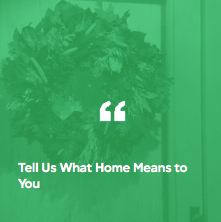
Tweet: Share what you are thankful for this Thanksgiving…
Status
Share what you are thankful for this Thanksgiving with the hashtag #ShareHomeIs https://t.co/rlHGcRwRhk
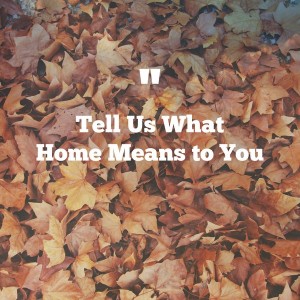
Tweet: Share what you are thankful for this Thanksgiving…
Status
Share what you are thankful for this Thanksgiving with the hashtag #ShareHomeIs #MakeRoom
Tweet: Share what you are thankful for this Thanksgiving…
Status
Share what you are thankful for this Thanksgiving with the hashtag #ShareHomeIs
Tweet: Share what you are thankful for this Thanksgiving…
Status
Share what you are thankful for this Thanksgiving with the hashtag #ShareHomeIs
Tweet: Share what you are thankful for this Thanksgiving…
Status
Share what you are thankful for this Thanksgiving with the hashtag #ShareHomeIs https://t.co/bJFHq05xEH
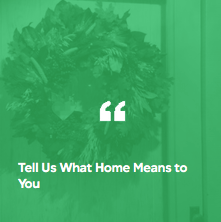
Tweet: Share what you are thankful for this Thanksgiving…
Status
Share what you are thankful for this Thanksgiving with the hashtag #ShareHomeIs.
A Home for Everyone: The Unfulfilled Promise of Thanksgiving
On Thursday morning, when I fly from Los Angeles to Utah for Thanksgiving with my family, there will come a moment when I’m reminded just how fortunate I am that I have a home to go to. So, I’m guessing, do you. Thanksgiving is practically synonymous with home. It’s part of what makes this holiday so meaningful. It’s what we picture when we think of the day, everyone seated around a table, at home.
But on the road to the airport that morning, I will see something that is all too common in this country: people who don’t have a home to go to. And as I go to celebrate the holiday with my family, a sad reality will set in: they likely don’t have anyone to celebrate with. They’re homeless, and they’re more numerous here in Los Angeles than anywhere else in the country other than New York City.
But then as the plane lands, something strange will happen. Homelessness, which had been so ubiquitous on the streets of my hometown, will practically disappear from sight. Utah, you see, has almost eliminated chronic homelessness.
Now, it’s worth mentioning that there are a lot of differences between Utah and Southern California. The price of housing, to name the most obvious, is a lot lower in Utah. But every state has thousands of homeless residents, and Utah was no exception until recently.
What changed in Utah was a program called Housing First. Starting in 2005, the state went to the chronically homeless and offered them a deal: For $50 a month or 30 percent of their income, whichever was more, the state would give them an apartment to live in.
Ninety percent took them up on it.
Utah doesn’t count chronically homeless residents in the thousands anymore. There are so few left that the statewide director of the program says he knows them by name. And because it costs more for the police and hospitals to deal with them on the street, giving them apartments has actually saved the state money.
It’s tempting to conclude from this story that the problem is easy to solve. It isn’t.
Despite its success in reducing chronic homelessness, Housing First has barely made a dent in the rest of the homeless population; the “other” homeless group that often drifts between temporary homes and outnumbers the chronically homeless by more than ten-to-one. A key problem is money. Even though it saves money in the long run, reducing homelessness requires more money upfront, and the National Housing Trust Fund that President George W. Bush established to address the problem has been raided by Congress to pay for other programs. Further, unless it comes with “wraparound” services like substance-abuse treatment and job training and placement, providing housing is unlikely to generate the self-sufficiency needed for formerly homeless people to stay in their new homes. And of course it does nothing to prevent Americans from becoming homeless in the first place.
The sad reality is that the pathways to homelessness are many and complex, ranging from substance abuse to domestic violence to mental illness. Children are particularly vulnerable. If they don’t have a support system at home, they may look for it in “street families” and gangs. Robin Petering, a PhD candidate at the USC School of Social Work, has interviewed the homeless youth of Los Angeles and found that over half of them have been closely affiliated with gangs. Most of them are no longer gang members, yet they’re treated as criminals, unable to transition into productive society.
“Perhaps most evident on Thanksgiving, home is family.”TWEET THIS
Clearly, housing cannot solve these problems alone, and that is because home is more than housing. Home is safety. Home is health. Home is self-sufficiency.
Perhaps most evident on Thanksgiving, home is family.
And that is why it was so moving to see HUD Secretary Julián Castro post the following to Twitter earlier this week: “Up to 40 % of homeless youth are LBGT. LGBT persons are often rejected from their homes because of who they are.”
Rejected from their homes. Of all the tragedies in the human experience, can any be more antithetical to what we celebrate on Thanksgiving, this anniversary of many of our ancestors finding a home in a new land? They too were rejected, and the native peoples of this great continent stood ready to welcome them.
Cherish the home you find yourself in this Thanksgiving. I will cherish mine. Then, when the celebration is over, I will fly back to Los Angeles, and I will get back to working with you to fulfill the promise this nation once represented to a brave band of homeless pioneers who came to these shores in search of a home for all who would one day call themselves Americans.
Tweet: Home is where we want to be for the holidays. #Sha…
Status
Tweet: Home is where you keep your memories where you can…
Status
Home is where you keep your memories where you can always see them. #ShareHomeIs https://t.co/pOS9X27TRe
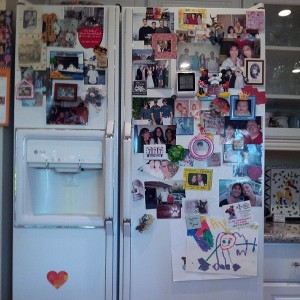
Tweet: @NWHomePartners are running a brilliant end of yea…
Status
@NWHomePartners are running a brilliant end of year campaign! @neighborworks #homematters #nwtogether #sharehomeis https://t.co/OBqDXpfPx5
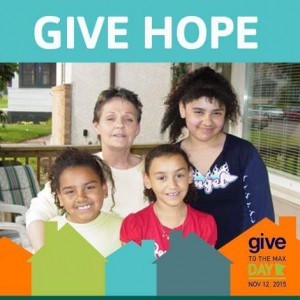
A Matter of Life or Death: How Better Homes Make Us a Healthier Nation
Middle-aged white Americans have been dying at an accelerating rate for the last fifteen years. This is surprising to, well, pretty much everyone. Perhaps you heard it on the news. Almost immediately after winning the 2015 Nobel Prize in economics, Angus Deaton and Anne Case dropped this bombshell finding in the Proceedings of the National Academy of Sciences. And the nation, appropriately, was alarmed.
Now, the first thing I should say is that I’m not an expert on death. I’m not a clinician or even a health policy expert. But from my career in housing research, I can tell you something about death that hasn’t often been reported in the news: Where you live has a significant effect on how long you live.
Clarity on this issue came for me during my time serving at the Department of Housing and Urban Development. There, I spent many hours with Ron Sims, who was Deputy Secretary at the time. Sims had worked with local leaders in King County to show that you could predict health outcomes by the ZIP code someone lived in.. He brought this notion to HUD and, under his leadership and that of the then-Secretary Shaun Donovan, the phrase “the best predictor of a person’s life outcomes shouldn’t be the ZIP code one lives in” became a departmental mantra. Sadly, today it often is. Obesity, illness, morbidity – they all vary significantly with where you live.
There were signs of trouble before the news of Case and Deaton’s research broke.
Last week, the New York Times ran an article with the headline, “Small Towns Face Rising Suicide Rates.” The victims and their communities had a lot in common. The article quoted one psychologist who pointed out that rural areas tend to have “lower incomes, greater isolation, family issues and health problems.” In fact, if you located those counties on a map published by the Times a few days earlier, you would find most of them in areas where an unusually high percentage of the population still don’t have health insurance. If you dug a little deeper, you would also find, as the Times did, “that 55 percent of counties in the United States—all of them rural—do not have a single psychologist, psychiatrist or social worker.”
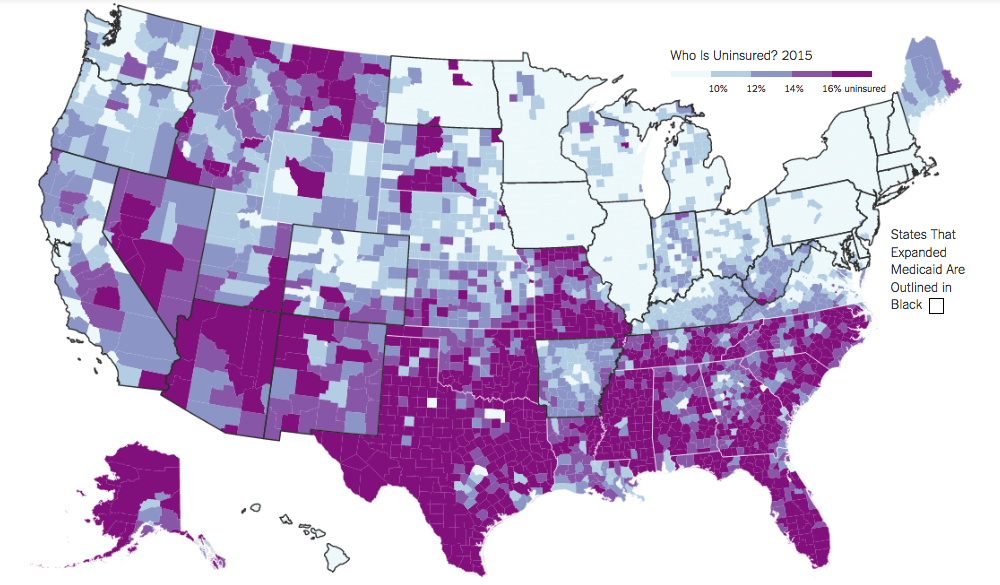
A couple days later, economists at the Federal Reserve Bank of New York published a map of their own, showing the average life expectancy in each county. Aside from the choice of colors, it was nearly identical to the health insurance map. If you lived in the healthier counties, you could expect to live a full decade longer than you’d live in others.
I’ll say it again: Where you live has a significant effect on how long you live.
Housing researchers have known this fact for some time. A large body of evidence shows all the ways that your home, your neighborhood, and your environment affect your health. In the last year alone, studies have found that higher rent costs lead to worse health; more violent neighborhoods lead to higher rates of depression; moving to a better neighborhood tends to reduce obesity; more environmentally friendly neighborhoods lead to better health for the sickest residents; and crucially in light of Angus Deaton’s latest findings, we have known for over a decade that families who move to low-poverty neighborhoods experience better mental health.
“Where you live has a significant effect on how long you live.”TWEET THIS
Some of these objectives are economically and politically difficult to achieve, but some are as simple as building better homes. Just last month, researchers at the Harvard School of Public Health reported that people living in environmentally friendly homes were significantly less likely to experience “sick building syndrome” – dizziness, itching, and sneezing fits due to hazardous chemicals, mold, and poor ventilation.
The effects are particularly acute in children. The Harvard researchers found that kids in “green” homes were less than half as likely to experience symptoms of asthma and 75 percent less likely to be hospitalized or miss school for asthma attacks. And it’s not just green homes. Another recent study shows that kids’ brains develop better when they’re exposed to more green space and less air pollution. Yet another shows that spending more than 30 percent of a family’s income on housing can impair their children’s cognitive achievement.
These effects can last a lifetime.
In discussing the research, Deaton told the press, “Drugs and alcohol, and suicide…are clearly the proximate cause.” Note the word proximate. Drugs and alcohol don’t walk up to strangers and kill them in the street. Something leads people to drugs and alcohol, and suicide. They may be the proximate cause. Something else is the ultimate cause.
I don’t know the underlying reason that mortality has ticked up in middle-aged white Americans. At the moment, nobody does. But I do know that these victims are not distributed equally across the country. This kind of suffering is far more pervasive in homes that lack the resources and the support system to combat the illness before it’s too late.
We can start by building better homes. And then, better neighborhoods. And eventually, block by block, a better, stronger, healthier nation.
Tweet: Our favorite: Where I feel accepted and at peace #…
Status
Instagram picture
Day 9: Home of the free, because of the brave. #mercyme15
#freedom #united #unitedwestand #america #proud #americanflag #military #pride #November #photochallenge #contest #HomeIsHope #nonprofit #affordablehousing #community #support #giveback
Instagram picture
Day 8: Today, take time for yourself! #mercyme15
#rest #rockingchair #takeyourtime #relax #November #photochallenge #contest #HomeIsHope #nonprofit #affordablehousing #community #support #giveback
Instagram picture
Day 7: “Look deep into nature, and you will understand everything better.”–Albert Einstein. #mercyme15 #nature #gardening #garden #November #photochallenge #contest #HomeIsHope #nonprofit #affordablehousing #community #support #giveback
Instagram picture
Day 6: “Walking with a friend in the dark is better than walking alone in the light.”–Helen Keller. #mercyme15
#friends #bestfriends #Yahtzee #checkers #games #gamenight #November #photochallenge #contest #HomeIsHope #nonprofit #affordablehousing #community #support #giveback
Instagram picture
Day 5: It all starts with a solid foundation! #mercyme15
#work #construction #hardwork #workinghard #workit #foundation #November #photochallenge #contest #HomeisHope #nonprofit #affordablehousing #community #support #giveback
Instagram picture
Day 4: “Follow your bliss.”–Joseph Campbell. What makes you happy? #mercyme15
#happiness #sisters #playground #swingset #family #laughter #November #photochallenge #contest #HomeIsHope #nonprofit #affordablehousing #community #support #giveback
Instagram picture
Day 3: An old saying notes, “It takes a village to raise a child.” Who has served as a role model to you? #mercyme15
#rolemodel #november #photochallenge #contest #HomeIsHope #nonprofit #affordablehousing #community #support #giveback
Tweet: Why is Home important to you? @HomeMattersUSA #Hom…
Status
Why is Home important to you? @HomeMattersUSA #HomeMatters #ShareHomeIs twitter.com/heyheybodie/st…
Tweet: Home is where my family shared laughs & love o…
Status
Home is where my family shared laughs & love on my sister’s 13th birthday #ShareHomeIs https://t.co/d36F0Azc4D
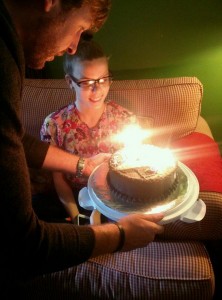
Instagram picture
Day 2: Beauty comes in all shapes, sizes, and colors. Share what you consider beautiful for our photo challenge! Don’t forget that you can participate in our photo challenge at any time throughout the month; you haven’t missed your chance to win! #mercyme15 #beauty #art #november #photochallenge #contest #HomeIsHope #nonprofit #community #support #affordablehousing #giveback
Instagram picture
Day 1: Today, we kick off our #mercyme15 photo challenge with Time. “The best gift you could ever give someone is your time.” Happy extra-hour-of-sleep day! #HomeIsHope #time #daylightsavings #november #photochallenge #contest #extrahourofsleep #nonprofit #community #affordablehousing #support #giveback


